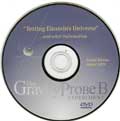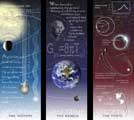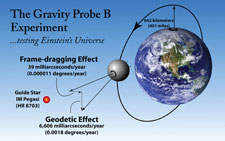WEEKLY UPDATE FOR 25 FEBRUARY 2005:
GRAVITY PROBE B MISSION STATUS AT A GLANCE
| Item | Current Status |
| Mission Elapsed Time | 311 days (44 weeks/10.25 months) |
| Science Data Collection | 182 days (26 weeks/6.0 months) |
| Current Orbit # | 4,589 as of 2:00 PM PST |
| Spacecraft General Health | Good |
| Roll Rate | Normal at 0.7742 rpm (77.5 seconds per revolution) |
| Gyro Suspension System (GSS) | All 4 gyros digitally suspended in science mode |
| Dewar Temperature | 1.82 kelvin, holding steady |
| Global Positioning System (GPS) lock | Greater than 98.5% |
| Attitude & Translation Control (ATC) | X-axis attitude error: 238.9 marcs rms |
| Command & Data Handling (CDH) | Multi-bit errors (MBE): 0 Single-bit errors (SBE): 9,937 (daily average) |
| Telescope Readout (TRE) | Nominal |
| SQUID Readouts (SRE) | Nominal |
| Gyro #1 rotor potential | -2.0 mV |
| Gyro #2 rotor potential | +6.9 mV |
| Gyro #4 rotor potential | -7.1 mV |
| Gyro #3 Drag-free Status | Backup Drag-free mode (normal) |
MISSION DIRECTOR'S SUMMARY
As of Mission Day 311, the Gravity Probe B vehicle and payload are in good health, with all systems functioning nominally and more than five months of science data collected. All four gyros are digitally suspended in science mode. The spacecraft is flying drag-free around Gyro #3.Three activities occupied our attention this past week:
- The Heat Pulse Meter Operation (HPMO), used to determine helium in the Dewar, occurred as scheduled on Wednesday night, 16-February. Preliminary analysis has been concluded and a sub-system level review is in progress.
- Star Sensor Magnitude Update was run Thursday to adjust the cataloged magnitude of star 173. As of Tuesday, updates of observed magnitude of stars 50 and 173 were successful. Other stars’ magnitudes may be updated.
- Two separate communications issues at Poker Flat, AK (2hr40m) and Wallops Ground Station (2hr50m) caused brief outages of data. All the data was recovered from Alaska; Wallops data was unrecoverable. Since the start of the mission, the GP-B team has successfully collected 99.0% of the data (requirement is 90%).
MISSION NEWS—GP-B EDUCATIONAL MATERIALS REACH 44 STATES AND 40 COUNTRIES

Have you ever heard of Maize, KS? Niceville, FL? National City, CA? Crookston, MN? Gig Harbor, WA? Nixa, MO? Rexburg, ID? Perhaps not, but curious teachers and students in these places have heard of Gravity Probe B!
In hundreds of small towns and big cities in 44 of the 50 states here in the U.S.A., plus Washington DC, educators and students have requested and are viewing GP-B Spacetime posters, GP-B Teacher Guides, GP-B Testing Einstein’s Universe DVD's and other educational materials.
 GP-B has truly become a national science education phenomenon! (In the U.S. map to the right, people from all the states colored blue have requested and received GP-B educational materials.)
GP-B has truly become a national science education phenomenon! (In the U.S. map to the right, people from all the states colored blue have requested and received GP-B educational materials.)
Shannon Range, our GP-B Educational Outreach Coordinator, has traveled to 18 states (from Oregon to Florida to Massachusetts to Minnesota) and in these places, he has presented the “GP-B: Testing Einstein’s Universe” story directly to over 2,000 teachers. Furthermore, here in the San Francisco Bay Area, Shannon has visited 35 schools, presenting the GP-B story and conducting various hands-on activities in numerous classrooms, reaching dozens of teachers and thousands of students.


 Our GP-B triptych (three-panel) poster, “Spacetime: The History, The Basics, The Tests” which was designed by Shannon, in collaboration with graphic artist Kate Stephenson and GP-B Data Processing Lead/Webmaster Jennifer Spencer, was chosen as one of the highlighted educational materials by NASA for the 2004-2005 school year. All told, we have mailed more than 2,000 of these posters, plus GP-B Educator's Guides and DVDs to nearly 700 educators and students around the world.
Our GP-B triptych (three-panel) poster, “Spacetime: The History, The Basics, The Tests” which was designed by Shannon, in collaboration with graphic artist Kate Stephenson and GP-B Data Processing Lead/Webmaster Jennifer Spencer, was chosen as one of the highlighted educational materials by NASA for the 2004-2005 school year. All told, we have mailed more than 2,000 of these posters, plus GP-B Educator's Guides and DVDs to nearly 700 educators and students around the world.

In fact, GP-B is not just a U.S. education phenomenon--it’s international. We have sent our Spacetime poster and other GP-B educational materials to 40 countries on six continents, from Argentina to Zimbabwe. The chart to the right shows that the countries making the most requests for GP-B educational materials thus far include Brazil, Portugal, India, England, Canada, The Netherlands, Pakistan, Germany, Estonia, Spain, and France (in that order).
We very much appreciate the world-wide interest GP-B has been receiving from educators, scientists, engineers, and the general public. Over 2,200 people from all over the world subscribe to the email version of these weekly highlights. We are always happy to receive comments and questions, and we do our best to answer all legitimate inquiries.
PLEASE NOTE: As of 2008, we have neither the staff nor the funding necessary to mail copies of our GP-B educational materials—GP-B Teacher's Guide, Triptych Poster, Litho Cards and Testing Einstein's Universe DVD—to teachers and educators upon request, as we once did. However, in the Education Resources section of this Web site, you can download PDF copies of the complete Teacher's Guide, all three panels of the Spacetime Triptych Poster (full-size 12" x 36" front and back), a set of litho cards, and a paper model of the GP-B spacecraft. Furthermore, much of the information and video from our Testing Einstein's Universe DVD, including the full 26-minute movie, Testing Einstein's Universe, is also available here on this Web site.
THE EINSTEIN EXHIBITION AT THE SKIRBALL CULTRAL CENTER IN LOS ANGELES
 If you're going to be in Los Angeles anytime before 30 May 2005, and if you’re interested in Einstein’s life and work, the Einstein Exhibition at the Skirball Cultural Center (just north of the Getty Museum on Interstate 405) is the most comprehensive presentation ever mounted on the life and theories of Albert Einstein (1879-1955). It explores his legacy not only as a scientific genius who re-configured our concepts of space and time, but also as a complex man engaged in the social and political issues of his era. It examines the phenomenon of his fame and his enduring status as a global icon whose likeness has become virtually synonymous with genius.
If you're going to be in Los Angeles anytime before 30 May 2005, and if you’re interested in Einstein’s life and work, the Einstein Exhibition at the Skirball Cultural Center (just north of the Getty Museum on Interstate 405) is the most comprehensive presentation ever mounted on the life and theories of Albert Einstein (1879-1955). It explores his legacy not only as a scientific genius who re-configured our concepts of space and time, but also as a complex man engaged in the social and political issues of his era. It examines the phenomenon of his fame and his enduring status as a global icon whose likeness has become virtually synonymous with genius.
In this exhibit, you can examine Einstein's report card, inspect his FBI file, and enjoy his family photographs, love letters, and diary entries. Exhibition highlights include scientific manuscripts and original correspondence—including original handwritten pages from the 1912 manuscripts of the special theory of relativity and his 1939 letter to President Roosevelt about nuclear power—and a wealth of other documents from the Albert Einstein Archives at the Hebrew University of Jerusalem.



In addition to these displays of Einstein memorabilia, the exhibit also features a number of interactive components that help provide an understanding of Einstein's revolutionary theories. Furthermore, several “explainers,” identified by their red aprons, are on hand to discuss various aspects of the exhibit and to explain and demonstrate difficult concepts, such as time dilation and warped spacetime. At the end of the exhibit, you’ll find one of GP-B’s gyro rotors on display.
The Einstein exhibition was jointly organized by the American Museum of Natural History (AMNH), the Hebrew University of Jerusalem, and the Skirball Cultural Center. It was designed by the AMNH under the supervision of Dr. Michael Shara, curator of the exhibit and chairman of the museum’s Astrophysics Department. It opened in November 2002 at the AMNH in New York and then traveled to Chicago and Boston, spending about 8 months in each location. It will remain at its final U.S. stop at the Skirball Center in Los Angeles through 29 May 2005, after which time it will move permanently to the Hebrew University in Jerusalem.
Information about the Einstein exhibition is available on the Skirball Center Web site. If you can’t make it to Los Angeles, you can visit the AMNH’s virtual Einstein exhibit on the Web.
Drawings and photos: The diagrams of the GP-B experiment and the photo collage of GP-B educational outreach activities were created by GP-B Public Affairs Coordinator, Bob Kahn. The photos of the spacetime poster, GP-B Educator's Guide, and Testing Einstein's Universe DVD, as well as the U.S. map and worldwide educational outreach chart are from the GP-B Image Archive here at Stanford. The photos from the Einstein Exhibit are courtesy of the Skirball Cultural Center. Click on the thumbnails to view these images at full size.
MORE LINKS ON RECENT TOPICS
- Track the satellite in the sky
- Photo, video & and news links
- Build a paper model of the GP-B Spacecraft
- Following the mission online
- Our mailing list - receive the weekly highlights via email
- The GP-B Launch Companion in Adobe Acrobat PDF format. Please note: this file is 1.6 MB, so it may take awhile to download if you have a slow Internet connection.
Previous Highlight
Index of Highlights

